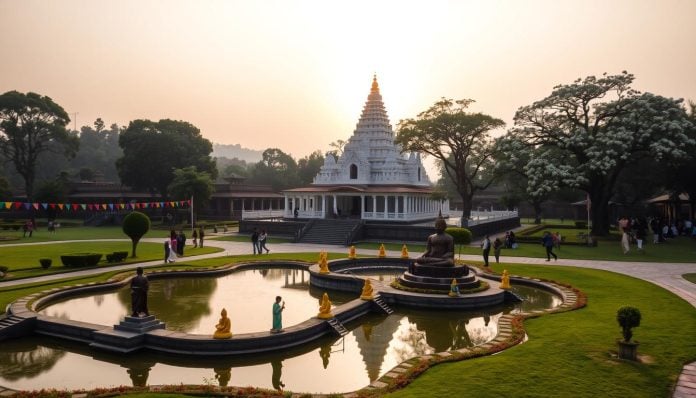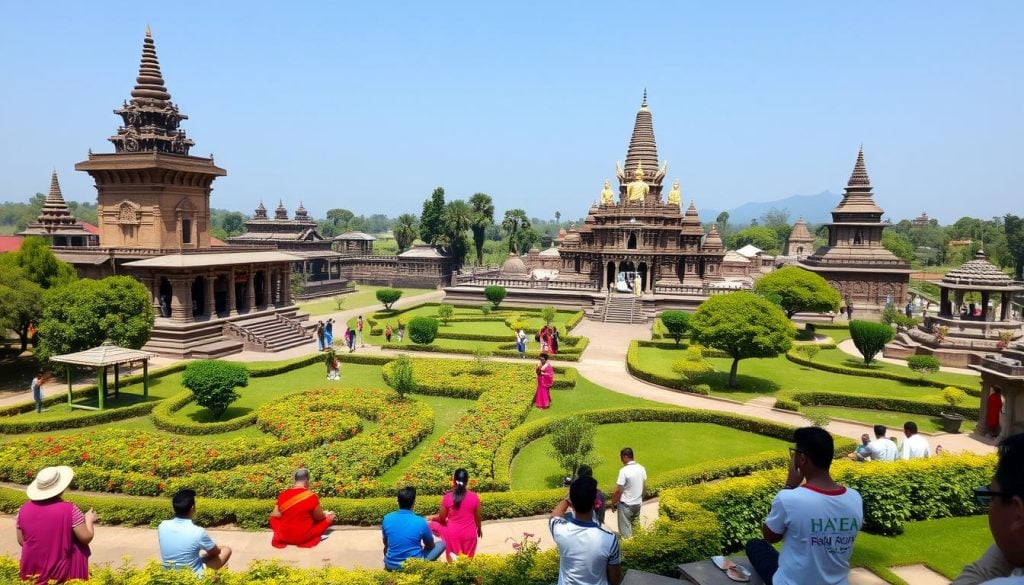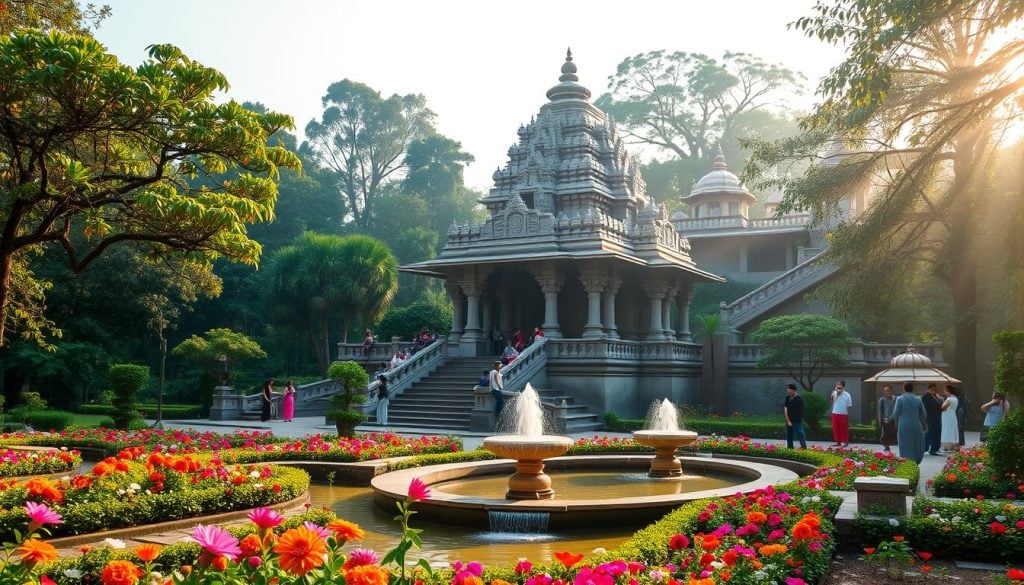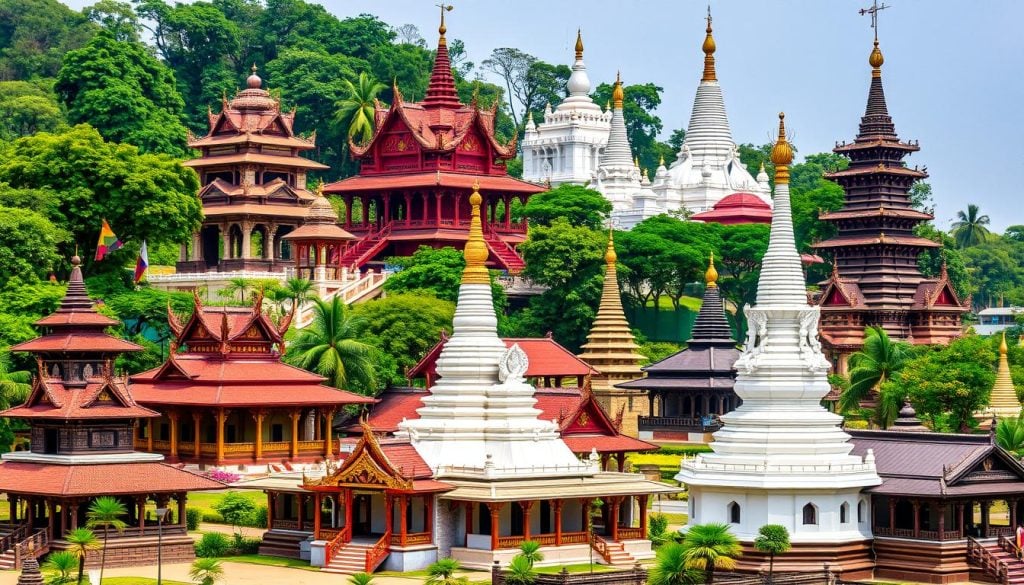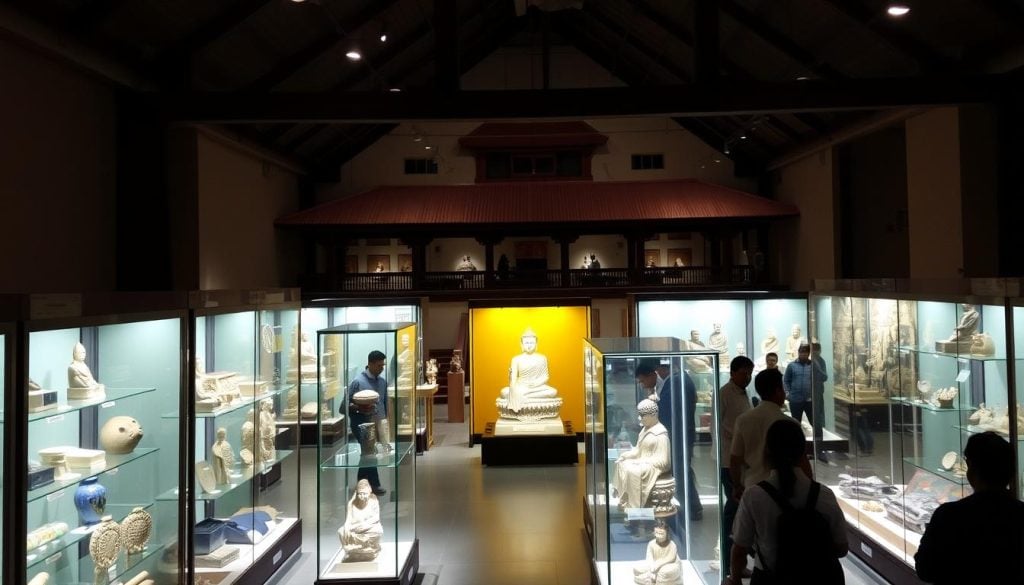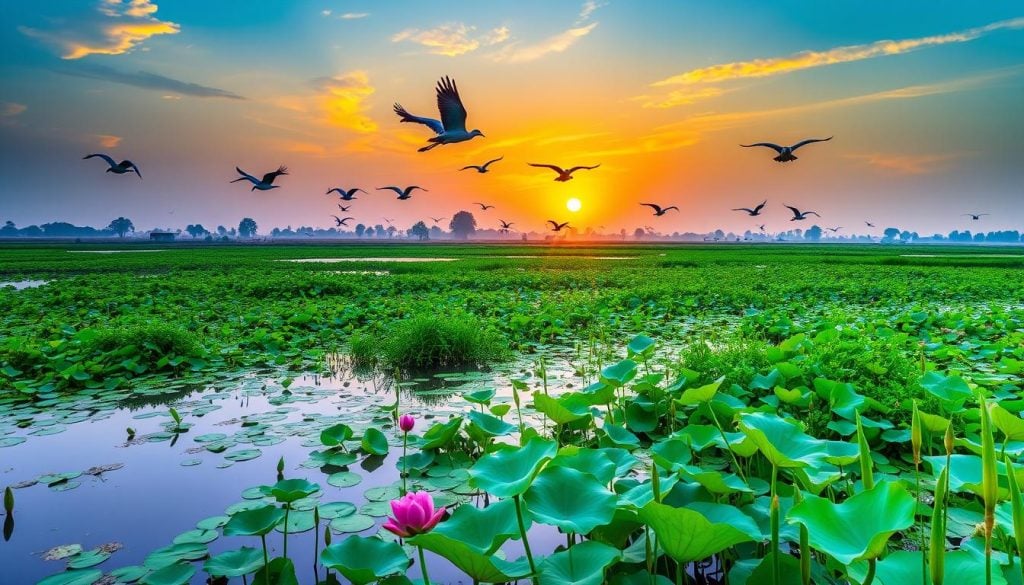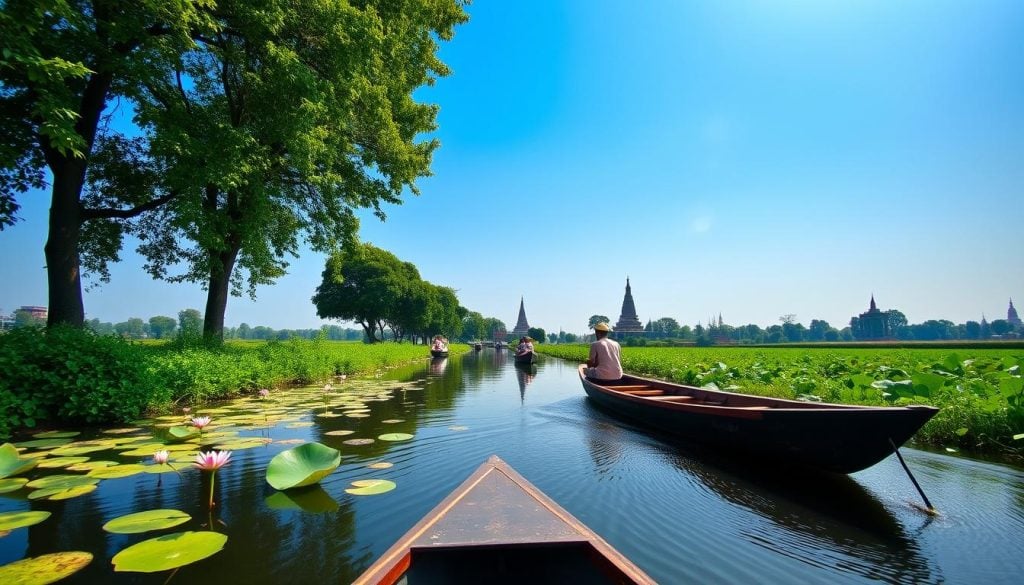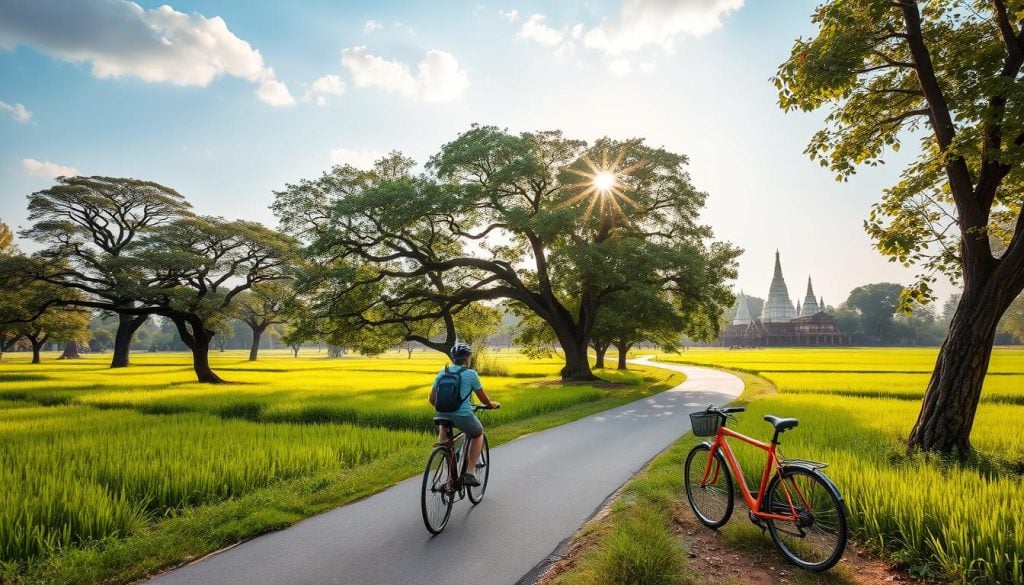Have you ever wondered why so many people visit Lumbini every year? They come not just for its history but for its deep spiritual feel too. This UNESCO World Heritage Site is where Buddha was born. It draws folks from different faiths. In this Lumbini travel guide, discover the top 10 activities in Lumbini. You’ll find everything from breathtaking temples to peaceful meditation spots. Each site offers a chance to touch the area’s rich cultural past.
Introduction to Lumbini: A Sacred Pilgrimage Site
Lumbini is a top sacred spot for Buddhists worldwide. It’s in Nepal’s Terai region, marking where Siddhartha Gautama, the Buddha, was born. Every year, it attracts thousands who come to explore its historical sites in Lumbini and dive into a deep cultural past.
The Lumbini complex is vast, home to over 30 monasteries showcasing diverse Buddhist traditions. The East Monastic Zone houses a stunning array of international monasteries. Meanwhile, the West Monastic Zone offers 14 monasteries and two spots for deep meditation, enriching visitors’ spiritual journey.
A key sight is the World Peace Pagoda, built by Japanese Buddhists for peace. The Lumbini Crane Sanctuary also stands out, devoted to the Sarus Crane, linking to Buddha’s spirit. These places add to Lumbini’s serene spiritual feel.
Exploring Lumbini by bike is an adventure, allowing you to see many historical sites in Lumbini easily. For those looking inward, several meditation centers offer peace and quiet. The Lumbini Museum, with its 12,000 artifacts, fascinates history buffs.
The best time to visit is from November to March, thanks to the cooler weather. However, with few hotels, booking early is key.
Maya Devi Temple: The Birthplace of Buddha
The Maya Devi Temple is at the heart of Lumbini, where Buddha was born. This place is on the UNESCO World Heritage Site list, drawing people who want to feel the deep spiritual vibe. The ruins show off a blend of Indian and Nepali designs. They also hold relics showing how important this site is.
The Historical Significance of Maya Devi Temple
Exploring Maya Devi Temple, you dive into history from the 6th century BCE. Emperor Ashoka, in 249 BCE, marked this place as holy. That helped make it a key Buddhist site. With the Ashoka Pillar and its ancient writings, visitors learn about the temple’s rich background. Entry costs 200 rupees for non-SAARC folks but is free for Indians, welcoming everyone to explore.
The Sacred Garden Surroundings
Around the Maya Devi Temple is the Sacred Garden, covering 8 square kilometers. It’s a spot full of peace and green beauty. You’ll find the ancient Bodhi tree and the Maya Devi Pond here. Legend says Buddha took his first bath in this pond. This calm setting is perfect for quiet thought or meditation. It connects visitors with Buddha’s wisdom, right in the heart of Lumbini’s landmarks.
| Key Features | Description |
|---|---|
| Maya Devi Temple | Believed to be established between the 6th century BCE, an essential site marking Buddha’s birthplace. |
| Entrance Fees | 200 rupees for non-SAARC nationals, free for Indians, 100 rupees for SAARC citizens. |
| Sacred Garden Area | Spans 8 square kilometers, featuring the historical Bodhi tree and Maya Devi Pond. |
| Historical Context | Designated as a sacred site by Emperor Ashoka in 249 BCE, significant for Buddhist pilgrimage. |
| Visitation Tips | Recommended to spend a half-day exploring, walking is a practical way to navigate the area. |
Top 10 Things to Do in Lumbini
Lumbini is full of experiences for travelers who love history and culture. The area is known for its stunning monasteries and stupas. Each one shows the unique architecture from different countries. This mix of designs makes Lumbini a key place to visit.
Visit Historical Monasteries and Stupas
While in Lumbini, make sure to see the Great Lotus Stupa and the Royal Thai Monastery. These places are not just spiritual hubs; they also show Buddhism’s rich history. Lumbini has over 62 archaeological sites that give a glimpse into Buddha’s life, drawing visitors from all over.
Every monastery stands as a tribute to its homeland, with designs that tell stories of national beliefs and styles.
Explore the Diversity of Monastic Architectures
Lumbini’s beauty shines in its diversity of monastic architectures. You’ll see monasteries from Myanmar, Japan, and China. They let visitors see how culture shapes spirituality. You can enjoy unique designs, from tranquil traditional motifs to modern takes on ancient beliefs.
A stroll among these architectural marvels deepens your Buddhism understanding and offers peace among nature.
The Ashoka Pillar: A Landmark of Buddhism
The Ashoka Pillar is a key symbol in Lumbini, a crucial place for Buddhism. It was set up by Emperor Ashoka in the 3rd century BC. This great pillar shows where Lord Buddha was born. Its importance goes beyond just being there. It shows how Buddhism has influenced many, for ages.
Rediscovery and Historical Context
This pillar was made to honor the birthplace of Buddha and found again in 1896. It had been forgotten over time. Weighing about 50 to 60 tons, it grabs your attention. The writings on it connect directly to Buddha’s life and ideas. When you visit Lumbini, the Ashoka Pillar draws you in. It makes one think of Buddha’s enduring spiritual legacy.
The Ashoka Pillar can be visited from 6:00 a.m. to 6:00 p.m. every day. People love to see its beauty while being mindful of the site’s sacredness. The best time to go is from October to March. That’s when Lumbini’s weather is most welcoming.
Remember, you can’t touch or climb the pillar. But taking photos is okay. This helps you keep the memory of this significant spot. For those wanting to stay close, there are places to stay within a mile. This makes it easy to dive deeper into the special feel of this respected site.
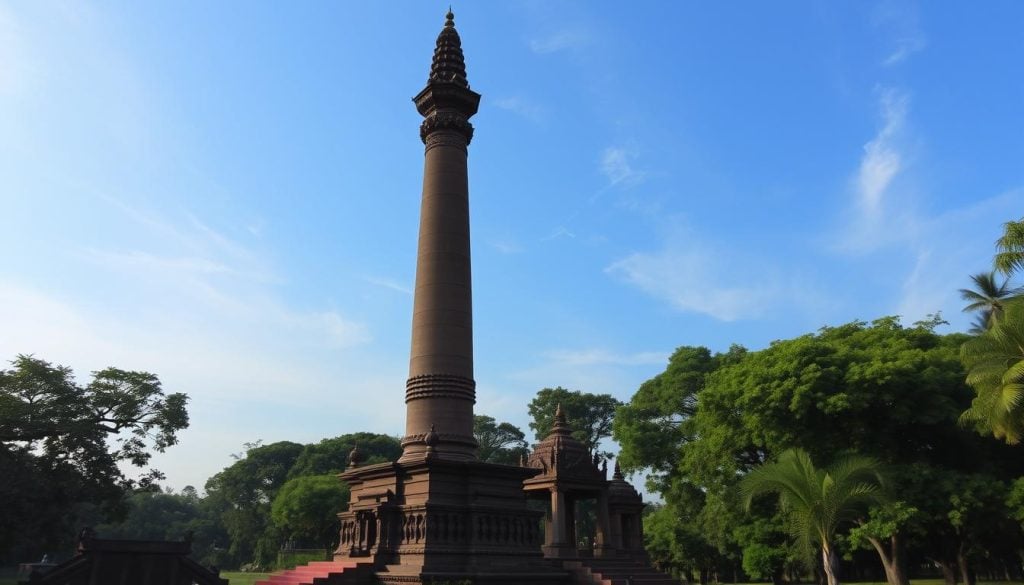
Lumbini Museum: A Treasure Trove of Artifacts
The Lumbini Museum is an essential place for anyone interested in history and culture. It contains over 12,000 artifacts, offering a deep dive into Buddhism’s evolution. Among the collection, you’ll find ancient terra-cotta pottery, coins, and manuscripts. There are also photos from archaeological digs from the Maurya and Kushan periods.
Noteworthy Exhibits and Collections
Inside the Lumbini Museum, several exhibits stand out:
- Terracotta Pottery: See pieces showing the skill of ancient craftsmen.
- Coins: Look at ancient currencies, showing over 2,500 years of economic history.
- Religious Manuscripts: Dive into texts that share early Buddhist teachings.
- Archaeological Photos: Get a visual history of important discoveries for the area’s vast heritage.
The Lumbini Museum’s wide array of artifacts enriches your knowledge of Lumbini’s history. It also underscores the site’s significance in Buddhist heritage. A visit here deepens your respect for the spiritual and cultural legacies shaping our world.
| Artifact Type | Details |
|---|---|
| Terracotta Pottery | Exquisite pieces demonstrating the artistry of early civilization. |
| Coins | Currency that reflects the economic practices of the Maurya and Kushan empires. |
| Religious Manuscripts | Texts preserving the fundamental teachings of Buddhism. |
| Archaeological Findings | Photographs showcasing significant archaeological excavations. |
World Peace Pagoda: A Symbol of Harmony
The World Peace Pagoda in Lumbini is a powerful sign of peace and togetherness. Built by Japanese Buddhists early this century, it stands for worldwide unity. It’s about 115 feet tall and 344 feet wide. The white outer part and a golden Buddha inside are stunning.
Many come to the World Peace Pagoda, making it a must-see in Lumbini. It’s a peaceful spot perfect for thinking deeply or meditating. Greenery surrounds the stupa, helping you feel calm and connect with Buddhist values.
About USD 1 million was spent to build the World Peace Pagoda. It shows a deep desire for global peace. Nearby, the Eternal Flame of Lumbini has been lit since 1986. It represents a lasting effort towards peace and unity.
Visiting Lumbini? Make sure to see the World Peace Pagoda. It’s not just beautiful architecture. It’s a place that brings people together in the spirit of harmony.
The Bodhi Tree and Maya Devi Pond: Sites of Meditation
The Bodhi Tree and Maya Devi Pond are key parts of Lumbini’s spiritual heart. As you walk through these holy places, you find yourself surrounded by a history rich with Buddhist traditions. People come to the Bodhi Tree seeking a moment of quiet meditation. They ponder its deep meaning as a symbol of enlightenment.
Not far, the Maya Devi Pond provides a tranquil spot. It’s believed to be where Buddha had his first bath. This calm area aids in mindfulness and helps visitors connect with Buddha’s lessons.
Religious Rituals and Local Beliefs
In Lumbini, colorful religious events bring together locals and pilgrims. They share in rituals, such as lighting oil lamps by the Maya Devi Pond. This creates a radiant scene that adds to the site’s spiritual feel. Many come here, especially during festivals, to honor the place where Siddhartha Gautama was born.
The Bodhi Tree is a central spot for meditation, chanting, and celebration. It fosters a bond among those gathered, building a community of faith and shared values.
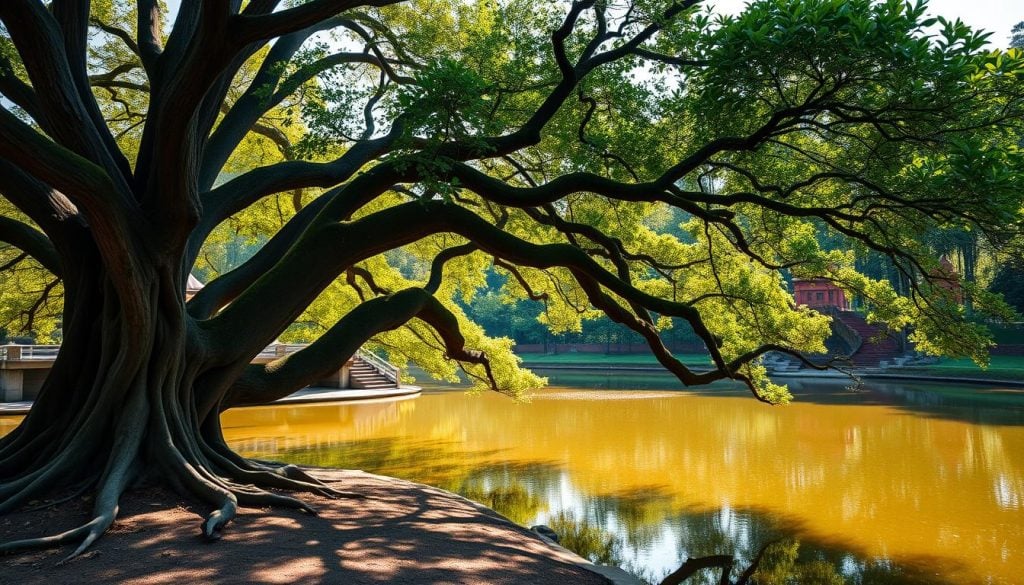
| Site | Significance | Activities |
|---|---|---|
| Bodhi Tree | Symbol of enlightenment and meditation | Personal meditation, group chanting |
| Maya Devi Pond | Site of Buddha’s first bath | Oil lamp lighting, community rituals |
Lumbini Crane Sanctuary: A Unique Attraction
The Lumbini Crane Sanctuary is a captivating spot in Lumbini. It shows off the area’s natural beauty and the connection between Buddhism and nature. Nestled in Lumbini’s peaceful setting, the sanctuary is a home for the Sarus Crane. This crane is loved for its symbols of love and loyalty in many cultures.
The Importance of Cranes in Buddhism
Cranes symbolize purity and peace in Buddhism. The Lumbini Crane Sanctuary lets you see these graceful birds up close. As you walk through this peaceful place, you learn about the cranes’ importance in Buddhist culture. The sanctuary helps protect endangered species. It also offers a place for quiet thought and enjoying nature.
At the sanctuary, you can go bird watching, take peaceful walks, and take beautiful photos. You’ll see the cranes and the lovely landscapes around them. This place not only makes you appreciate spiritual meanings more. It also helps with efforts to protect nature.
Boating on the Central Canal: A Relaxing Experience
Boating in Lumbini is a calm way to see the lush landscapes and amazing monuments at this UNESCO World Heritage site. The Central Canal offers a peaceful place for a smooth ride on the water.
When you boat on the canal, look around at the beautiful nature and wildlife. Also, see the important Buddhist buildings along the water. This relaxing activity is a key part of enjoying Lumbini, known for its peace.
Here are some tips for a great boating experience:
- Choose early morning or late afternoon for nicer weather and light.
- Pick a boat that feels right for you, considering comfort and price.
- Bring your camera to capture the beautiful scenes you’ll see.
- Plan your boat trip so it fits with other places you want to visit.
Boating connects you with nature and the spiritual feel of Lumbini. It’s perfect for alone time or with others, adding to your visit to this historic area.
| Boating Highlights | Description |
|---|---|
| Scenic Routes | Enjoy picturesque views of lush greenery and ancient architecture. |
| Wildlife Spotting | Look out for various bird species and other wildlife along the banks. |
| Relaxation | Experience tranquility, making it perfect for meditation or reflection. |
| Accessibility | Conveniently located with easy access from major attractions in Lumbini. |
Cycling around Lumbini: An Eco-Friendly Tour
Riding a bike in Lumbini lets you see its vast beauty while breathing in fresh air. The flat land makes cycling in Lumbini easy. You can visit many historical spots on your own time. See the famous Maya Devi Temple, where Buddha was born, and the peaceful Puskarini pond.
While biking in Lumbini, you’ll see over 15 monasteries from around the world. It’s easy to rent bikes near the bus park, making your trip smooth. This green way to travel keeps Lumbini’s nature and history safe.
Going around the central canal by bike takes you to big sites like the Lumbini Museum and World Peace Pagoda. These places show Lumbini’s deep past and calmness. By choosing to bike, you enjoy lovely views and help keep Lumbini’s environment safe.
Conclusion
Lumbini is a UNESCO World Heritage site that celebrates Lord Buddha’s legacy. It’s all about peace. Lumbini sightseeing offers enriching experiences. The Maya Devi Temple shows Buddha’s birthplace, while the Lumbini Crane Sanctuary offers calm.
At each historical spot, you dive deeper into Buddhist culture. Imagine exploring it all.
In Lumbini, you’ll find the Ashoka Pillar, ancient ruins, and peaceful gardens. These places allow for meditation and reflection. They show different architectural styles and Buddhist cultures. Lumbini is full of activities, from spiritual tourism to outdoor adventures and local crafts markets.
If spirituality or self-improvement calls to you, Lumbini is perfect for spending 4-5 days. There, meditation retreats, beautiful scenery, and the local Tharu culture await you. It’s more than a pilgrimage site; it’s about personal transformation.

































